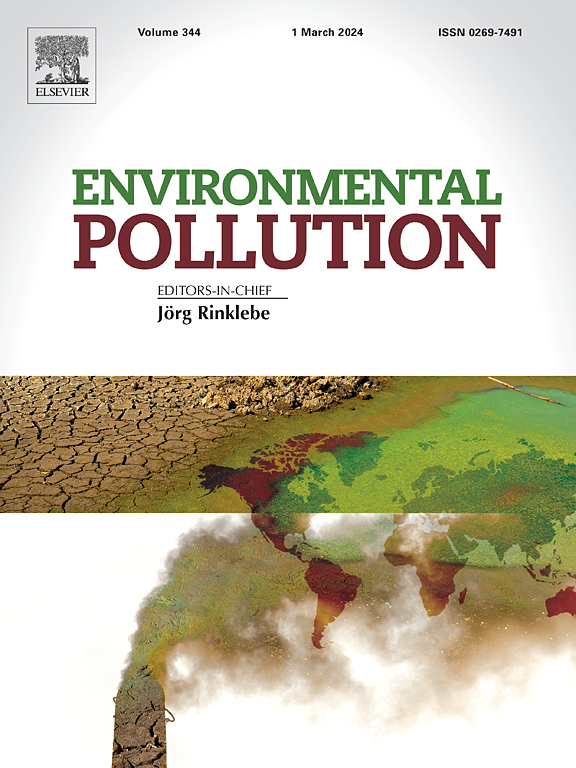Prioritization of legacy and emerging halogenated organic contaminants in humpback dolphins from northern South China Sea
IF 7.6
2区 环境科学与生态学
Q1 ENVIRONMENTAL SCIENCES
引用次数: 0
Abstract
Marine mammals are prone to accumulating elevated levels of halogenated organic contaminants (HOCs) due to their long lifespans, high trophic positions, and substantial lipid stores. However, which HOCs are of greatest concern in these apex predators remain largely unknown. Here, we constructed a toxicological prioritization index (ToxPi) model that integrates detection frequency, persistence, bioaccumulation, and endocrine-disrupting potential to evaluate priority HOCs in Indo-Pacific humpback dolphins (Sousa chinensis, n = 70) from the northern South China Sea (NSCS) between 2008 and 2018. Our findings revealed that legacy HOCs—particularly dichlorodiphenyltrichloroethanes (DDTs) and hexachlorocyclohexanes (HCHs)—ranked as the highest priority HOCs, highlighting their long-lasting health risk to the dolphins despite the global prohibition of these chemicals. Notably, although alternative halogenated flame retardants (AHFRs), as emerging contaminants, constituted the least proportion (0.03 %) among the HOCs analyzed, their ToxPi scores (0.38–0.44) were just below those of DDTs (0.46–0.53) and HCHs (0.48–0.50). This suggests that AHFRs may not be suitable substitutes for traditional flame retardants, and their potential ecological risks deserve further attention. Significant correlations were observed between hormones (thyroid hormones and testosterone) and high-scoring congeners within each HOC category. It is further supported that these priority HOCs may cause endocrine disorders in humpback dolphins through the actual measurement data. Overall, this study identified a priority list of HOCs in the NSCS humpback dolphins, emphasizing the need to monitor both legacy and emerging HOCs in marine mammals, without favoring one over the other.


南海北部座头海豚中遗留和新出现的卤化有机污染物的优先排序
由于海洋哺乳动物寿命长,营养地位高,脂肪储存丰富,因此容易积累高水平的卤化有机污染物(hoc)。然而,在这些顶级掠食者中,哪些hoc是最受关注的,这在很大程度上仍然未知。在此,我们构建了一个毒理学优先指数(ToxPi)模型,该模型综合了检测频率、持久性、生物积累和内分泌干扰潜力,以评估2008年至2018年间来自南中国海北部(NSCS)的印度太平洋座头海豚(Sousa chinensis, n = 70)的优先hoc。我们的研究结果显示,遗留的HOCs -特别是二氯二苯三氯乙烷(DDTs)和六氯环己烷(HCHs) -被列为最优先的HOCs,尽管全球禁止这些化学品,但它们对海豚的长期健康风险仍然突出。值得注意的是,虽然替代卤代阻燃剂(AHFRs)作为新出现的污染物在所分析的hoc中所占的比例最小(0.03%),但其ToxPi得分(0.38-0.44)仅低于DDTs(0.46-0.53)和HCHs(0.48-0.50)。这表明AHFRs可能不是传统阻燃剂的合适替代品,其潜在的生态风险值得进一步关注。在每个HOC类别中,激素(甲状腺激素和睾酮)与高分同系物之间存在显著相关性。通过实际测量数据进一步支持这些优先hoc可能导致座头海豚内分泌紊乱。总体而言,本研究确定了NSCS座头海豚中hoc的优先列表,强调需要监测海洋哺乳动物中遗留的hoc和新出现的hoc,而不是偏向于另一个。
本文章由计算机程序翻译,如有差异,请以英文原文为准。
求助全文
约1分钟内获得全文
求助全文
来源期刊

Environmental Pollution
环境科学-环境科学
CiteScore
16.00
自引率
6.70%
发文量
2082
审稿时长
2.9 months
期刊介绍:
Environmental Pollution is an international peer-reviewed journal that publishes high-quality research papers and review articles covering all aspects of environmental pollution and its impacts on ecosystems and human health.
Subject areas include, but are not limited to:
• Sources and occurrences of pollutants that are clearly defined and measured in environmental compartments, food and food-related items, and human bodies;
• Interlinks between contaminant exposure and biological, ecological, and human health effects, including those of climate change;
• Contaminants of emerging concerns (including but not limited to antibiotic resistant microorganisms or genes, microplastics/nanoplastics, electronic wastes, light, and noise) and/or their biological, ecological, or human health effects;
• Laboratory and field studies on the remediation/mitigation of environmental pollution via new techniques and with clear links to biological, ecological, or human health effects;
• Modeling of pollution processes, patterns, or trends that is of clear environmental and/or human health interest;
• New techniques that measure and examine environmental occurrences, transport, behavior, and effects of pollutants within the environment or the laboratory, provided that they can be clearly used to address problems within regional or global environmental compartments.
 求助内容:
求助内容: 应助结果提醒方式:
应助结果提醒方式:


